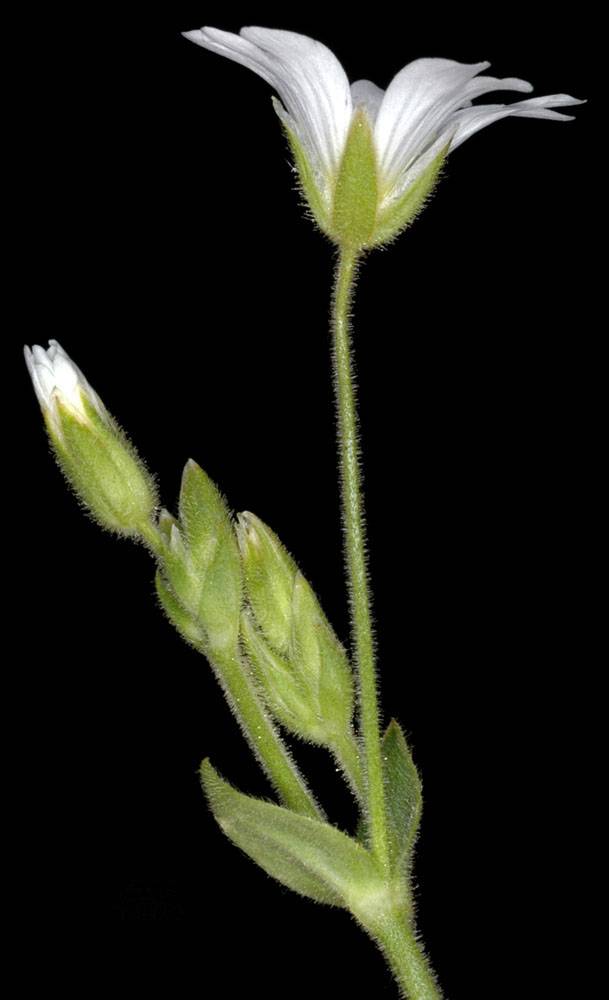
Plants perennial, usually not flowering in 1st year.
Stems 10–45 cm; non-flowering stems mat-forming; flowering stems erect, hairs glandular above, hairs not glandular, longer below.
Leaves on flowering stems ovate-lanceolate to narrowly oblong, 10–45 mm, often somewhat succulent; axillary leaves usually present in basal and mid-stem leaf axils.
Inflorescences open cymes; lower bract margins green, not scarious, uppermost bract margins white, scarious; pedicels in fruit 2–4+ × length of sepals.
Flowers sepals 6–9 mm, hairs densely glandular, rarely extending beyond sepal tip; petals shallowly 2-lobed, 10–15 mm, 2–3 × length of sepals; stamens 10.
Fruits nearly straight, 9–16 mm.
Seeds 1–1.5 mm.
2n=72.
Coastal banks and dunes, rocky slopes, open woods. Flowering Mar–Jul. 0–1300 m. Casc, CR, Est, Sisk. CA. Native.
Cerastium viride is closely related to C. arvense, and the two species can be very difficult to reliably separate; C. viride plants are often somewhat larger than C. arvense, with broader, somewhat succulent leaves. In Oregon, populations are chiefly coastal where C. arvense occurs less frequently.
as described under Cerastium viride
Plants perennial, mat-forming, strongly long-creeping rhizomatous. Stems: flowering stems ascending from elongate decumbent bases, branched, 15-45 cm, viscid, glandular in distal and mid-stem region, proximal portion with deflexed, long, soft, eglandular hairs, mostly in alternating longitudinal lines; nonflowering shoots horizontal, leafy. Leaves sometimes marces-cent, sessile, highly variable; blade tending to be succulent, pubescent on both surfaces or ± glabrous abaxially except on midrib and margins; leaves of mid and distal stem largest, blade ovate-lan-ceolate to linear-lanceolate or narrowly oblong, 15-42 × 3.5-7 mm, apex acute; proximal leaves smaller, with tufts of small leaves in their axils, blade oblanceolate to linear-oblong, 10-30 × 2-7 mm, often spatulate, apex ± obtuse. Inflorescences lax, 1-12-flowered cymes; bracts glandular-pubescent, proximal bract often foliaceous, broadly lanceolate to ovate-lanceolate; distal bracts lance-elliptic to lanceolate, margins narrow, scarious. Pedicels straight or sometimes curving near apex in fruit, tending to be stout, 10-35 mm, ca. 2-4 times as long as capsules, rarely more, pubescence dense, glandular, viscid. Flowers large and showy; sepals lanceolate, 6-9 mm, margins broad, apex acute, densely glandular-pubescent, viscid; petals broadly oblanceolate, large, 10-15 mm, 2-3 times as long as sepals, apex 2-fid; stamens 10; anthers 0.9-1.2 mm; styles 5. Capsules broadly cylindric, ca. straight, 8-15 × 4-5 mm, 1.5-2 times as long as sepals; teeth 10, erect, margins convolute. Seeds reddish brown, 1-1.5 mm, tuberculate; testa not inflated, tightly enclosing seed. 2n = 72.Cerastium clawsonii Correll, described from Texas, is a synonym of Linum hudsonioides Planchet (R. L. Hartman 1979).Flowering spring-early summer. Grassy slopes on coast, grassy and rocky slopes inland; 0-1000 m; Calif., Oreg.Some forms of Cerastium viride can be difficult to distinguish from larger forms of C. arvense subsp. strictum, but the broader capsule and leaves usually are diagnostic. In rare cases, chromosome number or pollen size [38-70 (average 43) µ in C. viride versus 28-40 (average 34) µ in C. arvense subsp. strictum] may be needed to confirm identification. Some of the inland material from Catsop County, Oregon, is atypical in having more slender pedicels, longer and softer pubescence, and more acute sepals.Cerastium viride often has been treated as a variety or subspecies of C. arvense. It differs from the native C. arvense subsp. strictum in being much larger in all its parts, and in chromosome number (2n = 72 in C. viride, 36 in C. arvense subsp. strictum). The two taxa do not hybridize in the wild and attempts to cross them in cultivation have failed. The introduced C. arvense subsp. arvense may be confused with C. viride. Both are strongly rhizomatous and the ranges of measurements for key characters overlap. However, the two taxa have different appearances, C. arvense subsp. arvense being a more slender plant with narrow leaves that are never succulent. In contrast, C. viride tends to be larger in all its parts, with sturdier, decumbent stems, and usually succulent leaves.
Excluded species: